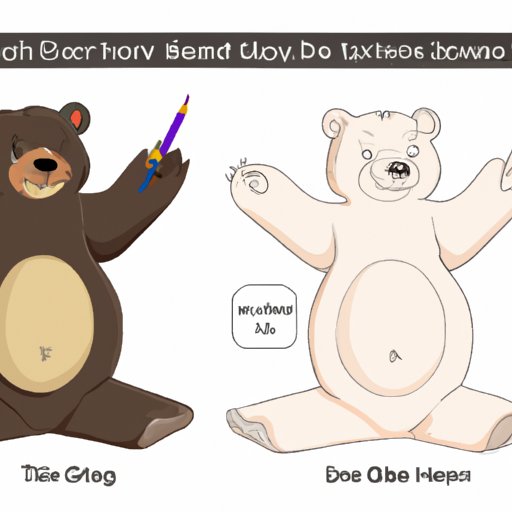
I. Introduction
Many people struggle to draw bears due to their complex anatomy and the difficulty of capturing their unique features. However, with the right techniques and guidance, it’s possible for anyone to learn how to draw a bear successfully. Whether you’re a beginner or an experienced artist, this article will provide you with a comprehensive guide on how to draw a bear that looks both realistic and cartoonish.
II. Step-by-Step Guide
To begin drawing a bear, start by sketching a basic outline of its body shape. Use simple shapes like circles, ovals, and rectangles to create a foundation for your drawing. These shapes will later help you add details and refine your drawing texture. After that, add more details like the bear’s eyes, nose, and mouth. When you’ve got the basic structure in place, begin adding fur and claws to your drawing using gentle, curved strokes. Finally, add shading to your bear to give it a more realistic appearance.
Remember that every bear is unique, so don’t worry too much about getting everything perfect. Use reference images of bears to help guide your drawing process and make adjustments as necessary. You’ll develop your own technique through trial and error.
III. Focus on the Head
One of the most important aspects of drawing a bear is getting the head just right. A bear’s facial features are essential for capturing its character and personality. Start by drawing the bear’s eyes, making sure they are spaced evenly and are the right size for your bear. Next, add the nose, which should be a small rounded triangle. The mouth should be large and open, with curved lines for the top and bottom lips. Finish off with the ears, making sure they are at the right angle and the right spacing.
When you’re done with the basic facial features, add in the fur on the head. Use curved lines to create the fur texture, and be sure to get the direction of the fur right so it looks realistic.
IV. Cartoon-Style Bears
If you’re looking for a more playful and whimsical drawing style, consider drawing a cartoon-style bear. These bears are characterized by their big eyes, small noses, and exaggerated features, making them easy to draw and fun to look at.
When drawing a cartoon bear, try adding bright colors and patterns to make it look more interesting. You can also use different line weights to create depth and texture.
V. Using a Grid System
Another great way to get better at drawing bears is by using a grid system. Simply divide your drawing surface into a grid of squares, then copy the image of a bear onto the grid square by square. This will help you break down complex shapes and patterns into smaller, more manageable sections.
The easiest way to use the grid system is to make a grid on your reference image. Then draw a larger grid on your paper and replicate the contents of each box of the reference grid to the corresponding square on your paper.
VI. Different Types of Bears
Bears come in all shapes and sizes, and it’s important to understand the characteristics of different species when drawing them. For example, polar bears have thin, flat ears, and brown bears have round, furry ears. The key is to pay attention to these differences and capture them in your drawing.
When you’re drawing a bear, try to research its different species to get a better understanding of its unique characteristics and features. This will help bring realism and clarity to your artwork.
VII. Up-Close Details
Finally, when your bear is taking shape, it’s time to add the details that will bring it to life. This includes adding shadows and highlights to the bear’s claws and teeth. Use darker colors for the shadows and lighter colors for the highlights to create depth and dimension on your bear’s body.
Also, make sure you get the direction of the shadows and highlights correct based on the light source in your scene. For up-close details, look at reference images to help guide your decisions.
VIII. Conclusion
Drawing a bear can be challenging, but with the right techniques and practice, anyone can learn how to do it. Start by following these steps to draw a basic bear outline, then experiment with different styles and techniques to create something unique and special. Keep practicing, have fun, and enjoy the journey!
This article explores how to draw a bear using different techniques and styles that can appeal to both beginners and experienced artists. It provides a comprehensive step-by-step guide that includes the bear’s basic outline, details, head, fur, claws, and more. By following the tips provided in this article, readers can learn how to draw a bear accurately and creatively, and develop their own drawing technique over time.





